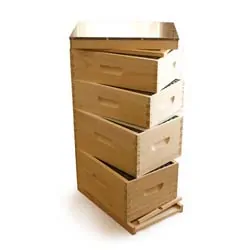Introduction
As you can imagine, moving bees, comb, and honey is not an easy task and should not be undertaken lightly. In addition to the weight of and potential damage to the hive, it has a tremendous impact on the bees.
Bees perceive the hive entrance as a GPS coordinate in space. If they arrive there and don’t find the entrance, they will not be able to get back in the hive and will ultimately die before their time.
For this reason, if you must undertake moving a hive, it must be moved less than three (3) feet or more than two (2) miles. I can’t emphasize this enough. Never move a hive more than three feet but less than two miles to avoid bee confusion and death.
When is it OK to Move a Hive
Unless there is a pressing reason, however, it’s preferable to leave the hive in the spot it began. Moving bees is quite disruptive for them, as well as a significant undertaking for the beekeeper and will likely require the beekeeper to seek assistance from strong people.
How to Move a Beehive
If you’ve determined that you must move you hive, there are some important steps that must be taken to ensure that move occurs with the least damage and the entire bee colony moves with the hive.
- Make sure the hive will be moved less than three feet or more than two miles
- Follow the site selection process outlined in our article “Installing and preparing your beehive“
- Wait till after dark before moving bees, if possible. This will ensure that all the bees who were out foraging during the day are at home and will move with the colony. If you cannot move the hive after dark, the prep work for moving it listed in the following steps must still be done after sunset and the hive moved as quickly as possible after sunrise.
- After all the bees have arrived home, block the entrance to the hive in such a manner that still allows airflow. Wrapping the hive in a material such as tulle is one effective way to do this.
- Keep the hive as level as possible to avoid damage. If the hive is being moved within the same bee yard, carefully walk it to the new location. If it’s being moved any distance, carefully, and as levelly as possible, load the hive on to a pickup truck or other open vehicle appropriately sized to hold the full length of the hive(s). For upright hives such as Langstroth and Warre, this is fairly easy. For horizontal hives such as top bar, this is a bit more challenging.
- When you arrive at the new location, carefully unload the hive, again keeping it as level as possible, and place it in its new permanent spot.
- Remove the entry block. If you used tulle, completely unwrap the hive. When the bees leave the hive now, they will recognize that it’s in a different location and record the new GPS coordinates. If it’s been moved less than three feet, the bees will not notice a difference.
- Leave the hive alone for a few days to a week. This will give the bees time to clean up any comb or honey that was damaged in the moving process and feel comfortable in their new environs.
- Resume hive inspections and other management techniques you employ as normal.
- Breath a sigh of relieve that it was a successful move.
Summary
It is best to leave hives in one location for the entire season, but there are life circumstances that arise and sometimes necessitate that your hive be moved while full of bees, comb, and honey.
When this occurs, make your mantra “less than 3 feet or more than 2 miles,” don’t panic, and follow the steps above to help facilitate a hive move that is least disruptive to the bees and least stressful for you, the beekeeper.

